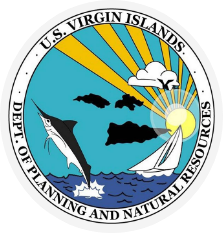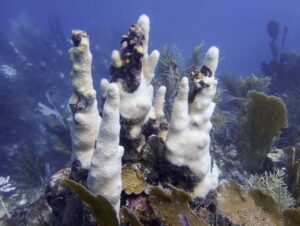“This past summer and fall, the US Virgin Islands faced an unprecedented mass bleaching event on our reefs,” stated Commissioner Jean-Pierre L. Oriol of the Department of Planning and Natural Resources. The National Oceanic and Atmospheric Administration’s (NOAA’s) Coral Reef Watch program reported unprecedented heat stress in the USVI, leading to severe coral bleaching and significant coral mortality. Territorial managers, researchers, field scientists, and local community members have all observed high levels of coral bleaching across the three islands.
This year, surface water temperatures in the USVI reached up to 33 degrees Celsius (91.4 degrees Fahrenheit), significantly higher than what the local corals are typically equipped to endure, even briefly. This year, corals faced prolonged exposure to elevated temperatures, leading to up to 100% mortality at some outplant sites of sensitive species.
“As we transition from the heat of summer and fall, water temperatures are decreasing, which is positive news for coral,” said Courtney Tierney, Coral Disturbance Response Coordinator. “Corals that have survived this year’s bleaching event will start to regain their color; however, these surviving corals still face challenges: they are weakened from the stressful bleaching and are now more vulnerable to disease and other threats. But we can help!” Tierney added.
For over 20 years, the NOAA Coral Reef Watch program has used remote sensing, modeling, and oceanographic data to report critical information on coral reef ecosystems worldwide. Their accurate satellite and modeling tools have provided marine resource managers, scientists, and other coral reef stakeholders with valuable predictions and reports that have served as early-warning systems on coral reef ecosystem changes, particularly during periods of severe marine heat stress.
The USVI monitored these tools and responded by implementing its Bleaching Response Plan as soon as heat stress was predicted. A subcommittee of representatives from local and federal organizations that work on coral health and conservation re-activates during every bleaching event. The group convened this year beginning in July to discuss response efforts to bleaching in the territory. The Bleaching Response subcommittee met regularly throughout the bleaching event to discuss the ongoing situation, monitor sea surface temperature across USVI, and plan and carry out bleaching surveys to determine impact and the best steps for intervention. After a bleaching event has occurred, scientists continue to monitor corals and the amount of damage done to the reefs to learn more about how we can help corals in the future.
Coral reefs face numerous threats from both land and sea, as well as from climate change. These threats include sediment runoff from land, improper waste disposal, pollution, agricultural chemicals, dredging, unsustainable fishing practices, and physical disturbances. Actions from both terrestrial and marine sources can significantly impact the health of these underwater ecosystems.
“You can make a significant difference in protecting our coral reefs. Help us safeguard and preserve the coral reefs around our island by raising awareness of the threats they face. Share this information with your family and friends. Familiarize yourself with local building, boating, fishing, and waste disposal rules and regulations to ensure the coral reefs remain as healthy as possible during future disturbances,” encouraged Commissioner Oriol.
To learn more about bleaching, coral disease, and more ways to help, visit vicoraldisease.org.
Photo credit: Nicholas Durgadeen, University of the Virgin Islands


